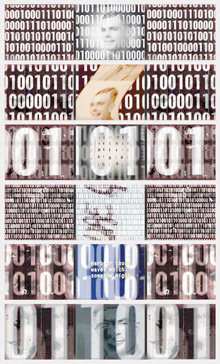The discreet charm of technology
dal 11/6/2008 al 23/8/2008
Segnalato da
11/6/2008
The discreet charm of technology
MEIAC Museo Extremeno e Iberoamericano de Arte Contemporaneo, Badajoz
Arts in Spain

Curators
Claudia Giannetti, Antonio Franco, Peter Weibel
This exhibition presents for the first time, both in Spain and abroad, a representative selection of over sixty artists and more than one hundred artworks that, by means of its thematic curatorial concept, will make it possible to retrace the principal aspects of production in art, science and technology that have been carried out in Spain from the earliest manifestations to the present day. In it, the 13th century is linked to the 21st through a modular approach that focuses on five key themes representative of the artistic condition: the formal code; the visual code; the sensory and space-time code; the body and the identity; and the construction of reality. Curators: Claudia Giannetti is an expert in contemporary art and media art, a theorist, writer and exhibition curator; Antonio Franco is Director of MEIAC, the Museo Extremeño e Iberoamericano de Arte Contemporáneo of Badajoz; Peter Weibel is Director of the ZKM Center for Art and Media of Karlsruhe (Germany).
MEIAC, Badajoz (Spain) and ZKM, Karlsruhe (Germany) present more than a hundred works, comprising the first anthological exhibition on media art production in Spain.
The consolidation of art involving audiovisual, computer, digital and telematic technologies is a fact, but in the visual arts, technology is muchmore than a mere instrument. The works in this exhibition do not necessarily contain technological media, but they are based on innovative proposals rooted in technology and science. The show features painting, sculpture and photography alongside interactive installations, experimental film, video and the Internet.
The curators have divided the exhibition into five thematic sections focussing on five broadconcerns in art and culture: ACTING ON THE FORMAL CODE; ACTING ON THE VISUAL CODE; ACTING ON THE SENSORIAL [SPACE-TIME] CODE; ACTING ON THE BODY'S INTERFACE; and ACTING ON THE REALITY INTERFACE.
The first section addresses the formalization of language, something first proposedby the meMajorca philosopher Ramon Llull (13th century), who created rules of binary combinations to achieve a universal language. Six centuries later, digital computers, automation, artificial intelligence and cybernetics were all developed upon this foundation. Artists such as Barbadillo and Alexanco, pioneers of computer art in Spain, applied combinatory practices and the generative system in their wrks. More recently, Leandre and Lozano-Hemmer continue to develop this line of investigation.
The drawings and micro-photographs of the famous scientist and Nobel Prize winner Santiago Ramón y Cajal, which open the second section, enabled the invisible to be visualiz modifying our perception of our immediate surroundings. New fields of vision and action are explored by artists such as Daniel Canogar, Moisés Mañas and Agueda Simó.
The third section, "Acting on the sensorial [space-time] code", analyzes, through José Val de Omar's pioneering experimental films, the capacity of the media to overcome the traditional limits of space, time and the senses. The installations of Eugènia Balcells and Pedro Garhel, among others, offer the spectator multi-snsorial immersive experiences.
The body as interface and the way in which the ideaof identity is constructed are some of the issues addresse by artists such as Pilar Albarracín, Marcel·lí Antúnez, Javier Codesal and Begoña Vicario. The body becomes a surface for exploring the individual as a perishable being, as well as an instrument for relating to society and questioning traditional concepts of gender.
Reality is a subjective perception which depends on how the subject is observed; that is the idea explored in the fifth and last section, entitled "Ating o the reality interface". Technoogicl means enable us to make clear the coincidence between fiction and reality. The artists whose works feature in this section aise questions about the relations between the subject and the surrounding social environment. Pioneers such as Miralda, Rabascall, Montes-Baquer/Salvador Dalí, Muntadas, Torres and Fontcuberta, as well as artists forming part of the latest generation, such as Cajaraville, Marino, Ruiz de Infante and Valldosera, present artistic proposals of special interest that touch on this broad question.
The catalogue, 600 pages, is undoubtedly the most complete publication ever produced in Spain on this theme. It contains hitherto unpublished historical and reflective essays by prestigious artists and theorists who are specialized in the field, such as Eugeni Bonet, Amador Vega, Román Gubern, María Pallier, Javier Echevarría, Simón Marchan Fiz, Muntadas, José Val del Omar and José María Yturralde, among others.
Curators
Claudia Giannetti is an expert in contemporary art and media art, a theorist, writer and exhibition curator.
Antonio Franco is Director of MEIAC, the Museo Extremeño e Iberoamericano de Arte Contemporáneo of Badajoz.
eter Weibel is Director of the ZKM Center for Art and Media of Karlsruhe (Germany).
Production
MEIAC, Museo Extremeño e Iberoamericano de Arte Contemporáneo
Organization
Ministry of Culture
General Department of Fine Arts and Cultural Assets,
Office for the Promotion of Fine Arts
Regional Ministry for Culture and Tourism of the Autonomous Government of Extremadura, Office for Cultural Heritage
Idea and Concept Claudia Giannetti
International Itinerancy
State Corporation for Spanish Cultural Action Abroad, SEACEX
Ministry of Foreign Affairs and Cooperation. The General Department of Cultural and Scientific Relations of Spain
ZKM Center for Art and Media Karlsruhe, Alemania ⎢ Germany
For more details about the artists and the works included in the exhibition, visit http://www.meiac.es/artesenespana
The net art can be seen at the virtual gallery on the exhibition website.
ZKM Center for Art and Media Karlsruhe, Germany
From September 26th 2008 to February 15th 2009
Press Department is:
Email: joseangel.torres@juntaextremadura.net Phone: (++34) 924 01 30 69
Opening: June 12th at 8:30 pm
MEIAC, Museo Extremeno e Iberoamericano de Arte Contemporaneo
Virgen de Guadalupe, 7 - 06003 Badajoz, Spain



